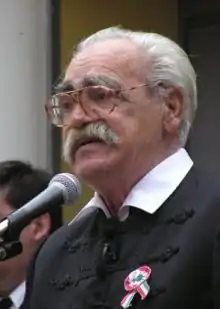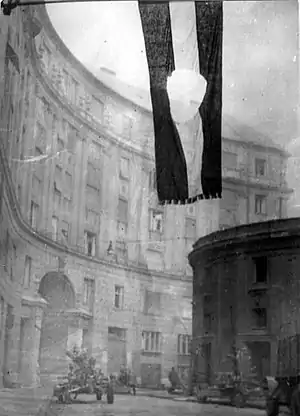Gergely Pongrátz | |
|---|---|
 Gergely Pongrátz speaking at the Corvin Passage in 2004. | |
| Born | 18 February 1932 |
| Died | 18 May 2005 (aged 73) |
| Nationality | Hungarian |
Gergely Pongrátz (Gherla, 18 February 1932 – Kiskunmajsa, 18 May 2005) was a famous veteran of the Hungarian Revolution of 1956. He was the commander of arguably the largest and perhaps the best-known group of fighters , at the Uprising's strongest and most lengthy point of resistance, Budapest's Corvin Passage (Corvin Köz); between 1 and 9 November 1956. Under his command, the Corvin Passage fighters destroyed Soviet armored vehicles, and resisted several waves of assault. Following the conflict, Pongrátz escaped capture and by 1957 had moved to the United States where he spent the majority of his exile until returning to Hungary in 1991. During his exile he was elected both Vice-Chairman and then Chairman of the Hungarian Freedom Fighters' Association (Magyar Szabadságharcos Szövetség).[1]
The Battle of the Corvin Passage

Armed civilians in the Corvin Cinema (the cylindrical building in the foreground of the picture) and surrounding buildings began to fight with the Soviet armoured forces as early as the night of 23–4 October. Taking advantage of the area’s excellent strategic conditions, the rebels of the Corvin Passage (Corvin Köz) soon became the Uprising's biggest and most important armed revolutionary group. Their valour was a decisive factor behind the favourable turn of events on 28 October.
The Corvin fighters were initially led by László Iván Kovács, with the young and charismatic Pongrátz taking command on 1 November. (24 at the time of the conflict he was nicknamed Bajusz, meaning "moustache.") Representatives of the Corvin Passage group negotiated several times with national political and military leaders during the ceasefire, and their influence on armed groups in their neighbourhood steadily increased.[1]
The Red Army began to attack the group in considerable strength on the evening of November 4. However, the defenders managed to hold their positions until the following afternoon, when the Soviets followed up an artillery bombardment with a further strong attack. The surrounding buildings were seriously damaged and the cinema itself caught fire.
Though they had destroyed at least a dozen Soviet Tanks, with little more than Molotov cocktails, the overwhelming force of the assault caused the group to abandon its base. Nevertheless, members of Pongrátz's Corvin Passage fighters continued their resistance as guerrillas in other parts of the city for several days. While others retreated into the cellars of the buildings until they were crushed by their enemy's superior numbers; the Communist forces having poured 31,550 troops and 1,130 tanks into Budapest.[2]
Politics
Following his return from exile in 1991, and in addition to his becoming president of the World Federation of Hungarians (Magyarok Világszövetsége), Pongrátz was a frequent and vocal critic of the successive Hungarian Socialist governments that came to power after the fall of the Iron Curtain. Despite the events of 1989, Pongrátz witnessed the democratic successor organization[3] to the communist party of his youth continuing to be the dominant political force in Hungary.
Depressed by what he saw as the continued presence and pervasive influence of former Hungarian communists in the senior posts of government, commerce and public life;[4] he became a leading figure in a new Hungarian nationalist movement, eventually participating in the foundation of a right-wing political party, the Movement for a Better Hungary (Jobbik Magyarországért Mozgalom), the third largest party in Hungary today.
Museum
Pongrátz first founded a museum of the 1956 revolution in 1991. It was closed in 1995 after the local authorities wished to use the building for a different purpose. Pongrátz then purchased and renovated an old school building in Kiskunmajsa and turned it into the only museum of the 1956 Revolution that exists in Hungary.[1]
Death
Gergely Pongrátz died on the grounds of his museum, after suffering a heart attack. Several high-ranking state officials, including the President of the Republic of Hungary, were present at his funeral. He died a year short of the 50th anniversary of the Hungarian Revolution.[5]
Personal life
He was married and had three children - one daughter and two sons.[6]
References
- 1 2 3 Partos, Gabriel (2005-05-28), Gergely Pongrátz: Resistance fighter in the Hungarian Uprising, The Independent (Obituaries), archived from the original on March 17, 2011
- ↑ Sources vary widely on numbers of Soviet forces involved in the intervention. The UN General Assembly Special Committee on the Problem of Hungary (1957) estimated 75,000-200,000 troops and 1,600-4,000 tanks (p. 56, para. 183), but recently released Soviet archives (available in Lib.ru, Maksim Moshkow's Library) list the troop strength of the Soviet forces as 31,550, with 1,130 tanks and self-propelled artillery pieces."Lib.ru/Фантастика: Чекмарев Владимир Альбертович. Будапешт 1956" (in Russian). Archived from the original on 2010-02-09. Retrieved 2014-05-22.
- ↑ Korosenyi, Andras (2000), Government and Politics in Hungary, Central European University Press, p. 64, ISBN 963-9116-76-9,
The successor to the Communist Party, the MSZP, is a 'cadre' party—it remains the party of the political class of the former system. Its political élite is recruited from the former nomenklatura, and the core of its voter base is formed in large part by former party members.
- ↑ Pongrácz: Átvészeltük Horn Gyulát is, Medgyessyt is, és én tudom, hogy Gyurcsányt is átvészeljük majd, accessed on 9 November 2013.
- ↑ Gergely Pongrátz: Resistance fighter in the Hungarian Uprising, London: The Times (Obituaries), 2005-05-25
- ↑ Erika Ozsda - Elfelejtett zászló - 11 July 2017